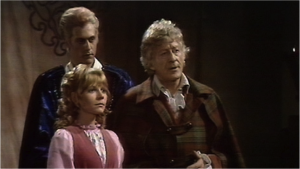The following guest post by Varad Mehta is part of our participation in this year’s edition of the For the Love of Film blogathon, hosted today by This Island Rod. This year’s theme is science fiction. Our purpose is to raise money to help the National Film Preservation Society restore a film. This year, we’re raising money to restore the 1918 Strand Comedy Cupid in Quarantine. Please consider donating to the effort here.
Science fiction has been political from start. I don’t mean when I say this that politics is all sci-fi is about. I mean simply that it has always had a political component and that a proper understanding of science fiction must take this into account. [1] H. G. Wells, who did more than anyone to make science fiction a distinct genre, here too did much to lay the foundation. The Time Machine (1895), his first book, imagines what evolution’s impact on social and class divisions might be. The War of the Worlds (1897) has long been perceived as (among other things) a commentary on British imperialism and late Victorian society. [2] As Andrew Hartman and Ray Haberski’s entries for the blogathon demonstrate, this aspect of sci-fi’s heritage remains vibrant to the present day.
The 1950s and ’60s were a boom time for political science fiction. Cold War anxieties and fears of nuclear war were dramatized in such movies as The Day the Earth Stood Still (1951), The Thing from Another World (1951), Them! (1954), and The Incredible Shrinking Man (1957) [3]. A decade later there arrived on American television screens what might be the exemplum of using science fiction as a vehicle for meditating on contemporary politics: Star Trek. This facet of Gene Roddenberry’s brainchild has been recognized since its birth, as former USIH blog ephor Mike O’Connor has documented. The prominent role played by a Star Trek: Deep Space Nine episode in Robert Greene II’s recent post on how science fiction has dealt with America’s so-called urban crisis demonstrates that this trait was inherited by its descendants.
Politics wasn’t nearly as prominent in another venerable 1960s sci-fi institution, Doctor Who, which premiered in 1963 and like its American cousin is still going strong. Nonetheless, in its fifty-two years the program has featured several stories which comment on current affairs. One could hardly expect otherwise. After all, when you can travel through time and space, anywhere can be a proxy for Earth.
Ironically, though, political themes didn’t really become important until the Doctor, for various production-related reasons, was exiled to Earth for several seasons during Jon Pertwee’s tenure as the Third Doctor (1970-74). [4] This was the show’s most overtly political era, and in the rest of this post I’ll discuss some of the political themes and issues which audiences would have seen the Third Doctor confront in the early ’70s.

Figure 2 The Doctor (Jon Pertwe) introduces himself to the other Federation delegates on Peladon as Jo Grant (Katy Manning), and King Peladon of Peladon (David Troughton) look on.
Once the producers adopted a contemporary setting, it was probably inevitable that they would tackle the issues of the day at least on occasion. One was the 1972 story “The Curse of Peladon,” in which the Doctor and his companion, Jo Grant (Katy Manning), are dispatched by the Time Lords (the Doctor’s people) to Peladon, a backwater planet which is being vetted for admission to the Galactic Federation in the year 3885 or thereabouts. The story can be interpreted as an allegory (I’d say a thinly disguised one) about the UK’s impending admission to the European Economic Community. The King of Peladon favors entry into the Federation, while the high priest, Hepesh, opposes it. They represent the two factions which persist in British politics to this day, the pro-Europeans on one side, the eurosceptics on the other. At the end of the story, the Doctor having foiled attempts to sabotage the negotiations, Peladon joins the Federation, as the UK would the EEC in 1973. Given the proliferation of euroscepticism in the UK in the last few years, one wonders how Peladon feels about the Federation today. It may be instructive for the current producers of Doctor Who to dispatch Peter Capaldi to find out.
“The Curse of Peladon” is a compact four-parter. Not every serial during Jon Pertwee’s time in the TARDIS was so economical. This was the age of what I call the “long and worthy” stories. [5] “Long” because they often had six or seven episodes (twenty-five minutes individually, or nearly two and a half hours spliced together in movie format, which is how they were broadcast on PBS in the 1980s and 1990s); and “worthy” because of their high moral purpose and edifying tone. There is a didacticism to them which makes you feel, not as though you’re being harangued exactly, but like you’re being fed something that is more nutritious than flavorful. [6]
Hence viewers were treated to interminable discourses on the evils of imperialism and racism (“The Mutants,” 1972) and the Cold War (“Frontier in Space,” 1973), among other subjects. “The Mutants,” referenced by name in The Satanic Verses, might take the crown for length and worthiness. Set in the thirtieth century, this story finds the Doctor again sent by the Time Lords to a backwater planet, Solos, to aid the local population. This time he has to prevent genocide: the colonial authorities of the Earth Empire are about to transform Solos’ atmosphere into one breathable by humans. This would render it unbreathable by the native Solonians, a side effect Sol0s’ human rulers have no compunction about sanctioning. Generally speaking, the Solonians are a native populace oppressed by alien (read: foreign) interlopers. The Earth authorities even operate a strict policy of segregation which vaguely resembles apartheid. For example, Solonians and “Overlords” (as the human administrators are known) use separate matter transmitters to transport them to Solos’ surface.
Why are humans on Solos? To extract its precious resources, of course! (As though this is the only reason Earthlings would venture into the solar system and beyond.) Earth in the thirtieth century is nothing but “Grey cities linked by grey highways across a grey desert. Slag, ash, and clinker – the fruits of technology,” as the Doctor puts it. The human administrator of Solos describes his home planet as “politically, economically, and biologically” exhausted.
The fear that Earth was heading for environmental catastrophe looms over many of the Third Doctor’s adventures, even those which take place far away from it. Doctor Who became political when it was moved to Earth, but many of its political stories are allegories set elsewhere. Its most political stories, though, were set on Earth. They had to be; they could not have been set anywhere else.
The political issue which received the longest and worthiest treatment during this era of Doctor Who was environmentalism. The modern environmental movement was just coming into its own in the early ’70s. Consequently, the Third Doctor was often embroiled in plots and schemes to find new sources of energy (“Inferno,” 1970, “The Claws of Axos,” 1971) and spending an awful lot of time in nuclear power stations (“The Silurians,” 1970).
The Third Doctor also went down a mine shaft or two. In the 1973 story “The Green Death,” he does so while investigating Global Chemicals, a petrochemical company touting a new process of refining crude oil which it promises extracts more fuel while reducing waste by a quarter. Locals who live near the firm’s new plant in Wales, though, are convinced the glowing green slime which has started oozing from the nearby abandoned coal mine and has sickened several people, is a result of the supposedly cleaner refining process. It can’t really be any cleaner, and if that’s so, the waste has to be going somewhere. As it turns out, it’s being dumped down the mine. “The Green Death” involves pollution, the environmental consequences of resource extraction, and corporate malfeasance. The opponents of Global Chemicals’ enterprise are (stereo)typical greens: they speak in broad Welsh accents, are unkempt, and live in a commune. Environmentalists are still seen as being akin to hippies, so it’s unlikely anyone batted an eyelash to see them portrayed as such when that link was still fresh in people’s minds. But that they’re the good guys is never in doubt: the Doctor sides with them.
The tables would be turned a year later in “Invasion of the Dinosaurs.” This story finds the Third Doctor and his new companion, Sarah Jane Smith (Elisabeth Sladen), returning to a London besieged by dinosaurs which manifest out of thin air and just as quickly return to it. The entire city has been evacuated while authorities investigate the gigantic reptilian menace. As the Doctor discovers, the appearance of the dinosaurs is the first gambit in a conspiracy reaching into the highest echelons of the British government and military.
A group of environmental activists and their sympathizers have decided that Earth has reached such a parlous state that the only solution is to start over. They will achieve this by using a “time scoop” to revert London to a point millions of years in the past. The purpose of the dinosaur “invasion” is to force an evacuation of the city and test the technology. Once Earth has been returned to a pristine condition, it will be repopulated by a handpicked group who have been told they are being transported to a “New Earth” in another solar system. Convinced of humanity’s failures, they hope to create a new civilization that will not succumb to such ills as overpopulation and environmental degradation. Once the scoop is activated, only those in its protective field will be saved as Earth is essentially reset.
If “The Green Death” presented the positive side of environmentalism, “Invasion of the Dinosaurs” paints it in darker colors. Here it is characterized by fear of technology, utopianism, and a grotesque humanitarianism which prizes humanity over humans. The term “ecoterrorism” did not exist in 1974, but given their actions and motivations the antagonists of the story could be described as ecoterrorists. They mean well, and the Doctor is sympathetic. But they are no less fanatical than the megalomaniacs the Doctor encounters on a regular basis, and their remedy would be worse than any disease they have diagnosed. The Doctor will no more countenance a genocide on Earth than he did on Solos. The road to perdition is paved with good intentions. “Utopia” is another name for “perdition.” As the Doctor tells one of the conspirators, “There never was a ‘Golden Age,’ Mike. It’s all an illusion.”
“The Green Death” and “Invasion of the Dinosaurs” provide a snapshot of British environmentalism in the early 1970s. They are also characteristic of the tenor of the program while Jon Pertwee piloted the TARDIS, suffused as it was with a concern for the pressing issues of the day. Political themes receded into the background once the Doctor’s exile was rescinded and he was free to roam about time and space once more. Jon Pertwee’s regeneration into Tom Baker’s Fourth Doctor, coupled with the arrival of a new production team, gave Doctor Who a new look and spirit. That isn’t to say political themes disappeared completely; they didn’t. But that tale, like a good Doctor Who serial, must be continued another day.
Notes
[1] Politics is in science fiction’s DNA. Sci-fi is a descendant of utopian literature, which was invented so authors could discuss political issues without advocating positions on current events, either of which action could get them in trouble. As Europeans colonized the whole planet, it became impossible to set stories in unexplored parts of the globe, since there were none left. The solution? Move the stories into the real undiscovered country: space. Or the future. And so utopian literature remains a living genre down to the present.
[2] Wells’ later novels, which are set in modern Britain, are overtly political, dealing with issues such as relations between the classes and sexes.
[3] This last film belongs to a second genre that was equally prevalent in the 1950s: movies about the uneasy condition of middle and upper class white men. If you watch movies from the 1950s, you’d never know that the decade they come from was considered for a long time a placid, even quiescent one. Perhaps it was this chimeric docility that let Hollywood play speculatively with angst; or perhaps Hollywood was simply more prescient in recognizing what was bubbling under the surface. Either way, this gives 1950s cinemas an odd character, as it is replete with apprehension about the status of well-to-do white men at a time when their supremacy in the country seemed impregnable. Which of course it turned out not to be.
[4] Political themes weren’t entirely absent before 1970. There are several discussions about the utility and aradiability of pacifism in “The Daleks” (1963-4), the second Doctor Who story and the one which made it a popular sensation. But such moments were rare.
[5] In their irreverent reference work The Discontinuity Guide (1995), Paul Cornell, Martin Day, and Keith Topping describe “The Curse of Peladon” as “Dull, but worthy.” Whether “long and worthy” is my own gloss on their phrase or I came up with it on my own is impossible for me to say at this point. See the BBC page for “The Curse of Peladon,” linked above.
[6] This was not, you may have gathered, my favorite era of the show.



4 Thoughts on this Post
S-USIH Comment Policy
We ask that those who participate in the discussions generated in the Comments section do so with the same decorum as they would in any other academic setting or context. Since the USIH bloggers write under our real names, we would prefer that our commenters also identify themselves by their real name. As our primary goal is to stimulate and engage in fruitful and productive discussion, ad hominem attacks (personal or professional), unnecessary insults, and/or mean-spiritedness have no place in the USIH Blog’s Comments section. Therefore, we reserve the right to remove any comments that contain any of the above and/or are not intended to further the discussion of the topic of the post. We welcome suggestions for corrections to any of our posts. As the official blog of the Society of US Intellectual History, we hope to foster a diverse community of scholars and readers who engage with one another in discussions of US intellectual history, broadly understood.
Utterly brilliant in every sense!!! My site colleague the Brit Allan Fish is one of the biggest DOCTOR WHO fans ever, but you have certainly given him a run for his money!! 🙂
Thanks for bringing attention to these serials, Varad.
One aspect which I find intriguing is the centrality of environmentalists themselves to the two serials which you highlight at the end. My impression is that environmentalists play a somewhat surprisingly small role in popular culture of the era which addresses environmental conflicts.
Some of the reason certain topics are chosen undoubtedly has to do with ideas about what makes for a good dramatic plot. For instance, in each serial, there appears to be a small group with a significant amount of power which is making decisions, and the TARDIS crew (an even smaller group) intervenes in order to save the day. But it is striking how often the serials present versions on the precautionary principle (the protagonists are willing to run significant risks), and how often they deal with quests for alternative energy sources. In that sense, they deal with debates central to the movement.
On the other hand, I am suspicious of the extent to which ““Invasion of the Dinosaurs” provide[s] a snapshot of British environmentalism in the early 1970s.” Visions of such dystopias represent fears outsiders have of the movement (and I think there is interesting commentary to be made about that), but they have almost no grounding in the actual proposals of environmentalists themselves – this sounds nothing like the politics of “Ecotopia,” or the consistent effort of environmentalists to make government more participatory, for instance. Interesting as a plot device, but so exaggerated as to be of little use in helping us think about environmentalist perspectives during the 1970s.
Jeff –
You may well be right that “The Green Death” and “Invasion of the Dinosaurs” don’t present a snapshot of early ’70s British environmentalism. It may be more accurate to say that what they offer is a snapshot of popular attitudes or impressions about the environmental movement. Though even that may be an overstatement, as I’m only going by what is shown on screen in Doctor Who. I know little about the actual ins and outs of British environmentalism back then. That it crops up so often in Doctor Who would seem to indicate that it had gained a foothold in the popular imagination. But the evidence probably doesn’t allow us to venture beyond that observation.
Sam –
Thanks for the kind words. I’m glad you enjoyed reading my post. I certainly enjoyed writing it.
Good stuff. I didn’t get started on the Doctor until Tom Baker assumed the role. I have to go back and seek these. The environmentalists in The Green Death sound like people I hung around with when I was a kid in San Francisco.